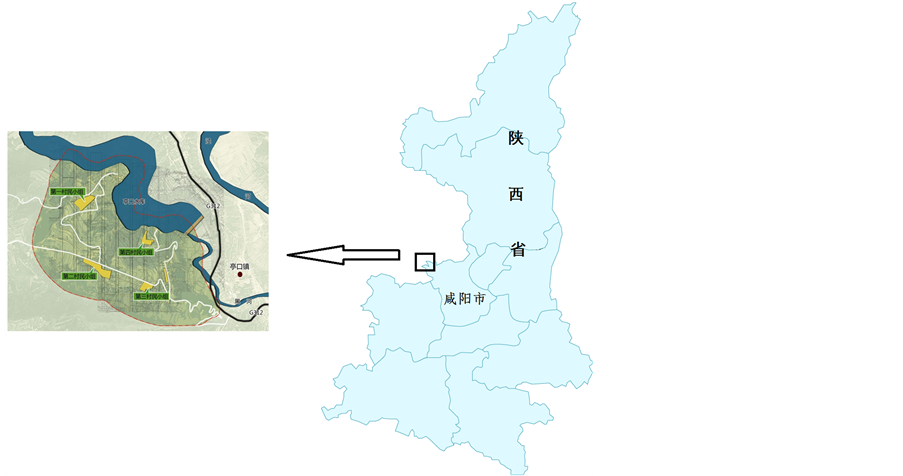1. 引言
陕西省是世界上气候影响最敏感的地区之一 [1] [2] 。近50年来已经经历了气候变化的影响,包括温度升高和降雨减少,同时,暴风、干旱、洪水、暴雨、大雪,以及突如其来的霜冻和冰雹等极端天气事件变得更加频繁和激烈,这些不利影响对陕西农业和农村发展造成了显著的影响 [3] [4] 。陕西省是中国西部代表省份,也是农业大省、贫困县大省,贫困县占全省的近乎一半 [5] 。因此,陕西面临扶贫攻坚和应对气候变化的双重挑战。
本研究前期在2012年通过全体村民半结构访谈、绘出社区资源图、大事记、不同性别和人群分别绘出农事历和灾害种类及强度、应对措施、社区关系图、矩阵排序与打分、入户访谈等方法获取陕西7个气候脆弱县区调研第一手材料;再根据社会经济学原理,分别从社区的贫困情况、气候脆弱性、敏感性、适应能力等76个指标进行研究;最终选出贫困成因具有普适性、社区所在地受气候变化影响明显、社区气候脆弱性高、适应能力弱、村民意愿和参与度高为特点的宇家山村社区作为研究区域 [6] [7] 。
宇家山村位于长武县亭口镇(图1),属于中国的“煤炭重镇”。全村有4个村民小组,合计159户,588人,其中女性190人,男性398人。社区村民年龄现状构成以46~65岁的中老年人以及19~30岁的青年人为主。全村以传统种植业为主,耕地总面积83.2公顷,主要位于山坡地。村民的主要生计途径即是以玉米、小麦等传统作物为主的种植业,2012年全村人均年收入约2100元。
该村村民原来大多分散居住在土窑洞、土坯房中,2009年告别了窑洞、危房搬进了相对集中的砖瓦结构的房屋,但基础设施水平较低,交通、市政等设施落后,农民生产、生活条件较差,缺乏支柱产业,经济发展缓慢。2013年,因附近“亭南煤业”发展导致农居区被采空,宇家山村决定实行整村搬迁,并确定采用全村农村居民集中安置的居住形式。由于当地长期以高碳排放的煤炭作为主要生活能源,村民居住的室内环境污染较为严重,对当地老人、妇女、儿童的生活质量和身体健康带来了较大影响;同时逐渐升高的温度加剧了本来就干旱的农业生产脆弱性;从当地气象数据的分析发现,极端天气和因气候变化产生的自然灾害有所增加 [8] - [10] 。
本研究以低碳可持续发展的理念围绕“提升农业产业经济效益,改善农村社区生活环境、提升农民参与度和知识/技术水平”三个方面,将低碳、适应气候变化工作与农村扶贫减贫紧密、有效结合,促进农业发展 [11] [12] 。
2. 方法
1) 建设低碳、节能、减排的抗震新村。在新村设计阶段,聘请气候变化专家、生态专家、农业专家对规划设计进行“适应/减缓气候变化审计”;
2) 用社会性别敏感的参与式工作方法,通过多项因地制宜产业培育、拓展当地村民的生计途径,改善生态环境,提高村民的收入水平;
3) 在农业生产、生活和农民能力建设方面引入一系列适应、低碳和可持续发展模式,促进农村社区的低碳可持续发展;
4) 减排计算见附录。

Figure 1. The location of Yujiashan village in Changwu, Shaanxi Province
图1. 长武县亭口镇宇家山村位置图
3. 结果
3.1. 农业生产过程中的扶贫、减贫和低碳适应
宇家山村是中国中西部农村社区的一个典型代表,传统种植业是当地的首要产业,也是农民赖以生存的生计来源。当地农作物以玉米、小麦为主,没有灌溉措施,靠天吃饭的生计模式严重制约了当地的经济发展和农民的生活水平。
研究首先结合当地以农业产业为支柱产业的特点,通过建立低碳式循环农业,提高当地村民农业经济收入,同时以低碳可持续发展的方式适应气候变化引起的干旱、极端天气:
1) 在传统农业作物种植基础上,结合当地自然资源和气候类型以及持续变化的气候影响,引入了适宜当地种植的玉米、小麦抗旱新品种,以适应气候变化对当地农业生产带来的不利影响。在抗旱品种引进的过程中,采用先开展小规模试验、让当地农民看到效果和实际情况后再决定选择哪种品种;同时在开展过程充分与村民进行交流和培训,在提升农户参与能力的前提下,引进品种,确保农户获得稳定的基本生活来源;
2) 根据当地土壤特性,尝试拓展多品种经济作物的种植,如增加油用牡丹、核桃、紫薯、花椒等经济作物品类的种植,品种选择采用农民自主选择的方式,每名农户可至少增加一种经济作物种植,种植面积先从小范围尝试开始,并根据实际效果逐年增加种植面积,最终拓展农户生计途径,增加农户经济收入;
3) 在第一产业农业种植的基础上,推进农产品深加工产业,在完成当地市场调研、与政府、村民访谈的工作后,确定推进柿子深加工特色产业,并通过协助村民建立柿饼专业合作社,配套和完善市场开发,如包装设计、农产品营销、电子商务培训等,实现第二产业的引入;
4) 沿袭村庄历史、文化、自然和社会资源,发展社区特色。宇家山村区域内目前正在建设“亭口水库”,作为周边地区的供水保证;因此,根据水库的建设进度,本研究协助当地逐步发展和引入“农业大棚”、“观光农业”、“生态农业”,并推进旅游业、服务业等第三产业的发展;
5) 在保证第一产业的可持续发展基础上,逐步推进第二、三产业的发展,而村民知识、意识和能力方面的建设至关重要,也是可持续发展的基础条件,因此本研究对全村村民进行了低碳循环农业、低碳产业发展、低碳生产方式进行了结合农时的实时技术培训,同时,50名村民参与了合作社、电子商务培训,建立了6个商铺,25名妇女参与了玉米皮、秸秆编织、刺绣培训,全体村民参与了有机/绿色食品等各方面培训和能力建设培训 [13] 。
3.2. 在当地推广低碳式的农业生产方式,促进扶贫、减贫工作的低碳适应可持续发展
在农业种植过程中采用生物肥料替代传统化肥,一方面可以促进农业增产,提高农产品价值,另一方面通过减少化学肥料的使用量,改善当地的土壤肥力,促进土地的可持续利用;
1) 通过筛选适宜当地条件的农田管理模式,并确定适合当地土壤条件和作物品种的施肥量。研究显示,现有肥料施用量减少20%不影响农产品收益且节省肥料支出,同时有效保护土地,还将明显减少施肥带来的氧化亚氮气体排放;
2) 安装40台太阳能杀虫灯,定期释放天敌1500万头,替代现有化学农药50%,抑制病虫害发生的同时建立与环境友好的农业生产模式;
3) 引入秸秆粉碎机4台,将玉米秸秆粉碎后全部还田,促进资源循环利用。
3.3. 社区生活过程中的低碳适应工作
新村建设将低碳可持续发展理念贯穿于与规划、设计、建设、以及运营管理的全过程,并覆盖社区生活居住、生活环境、生活用能等各个方面;同时为应对气候变化带来的自然灾害、极端天气对社区村民生活的影响,推进了一系列灾难防范和预警机制。
3.3.1. 生活居住:建筑设计
宇家山村所在地属大陆季风性气候,受季风的影响,冬冷夏热,夏季日照时间较长,因此在同时考虑舒适性和节能减排的条件下,房屋构造设计为“窄院”的建筑模式,这种狭窄的庭院形式影响采光但夏季宅院内可形成较大阴影区,避暑效果好,属于陕北地区传统的房屋构造模式,这种通过呈现不同的空间形态的建筑能够有效的适应当地气候和地理环境。
3.3.2. 建筑节能
宇家山村新村建筑不同于传统的农房设计,新村建设以不明显增加房屋建设成本的前提下,引入了多项建筑节能方案,包括:房屋墙体采用节能的空心砖,替代传统的实心砖,根据陕西省建筑节能与墙体材料改革办公室和砖厂厂商提供的信息,空心砖在制造过程中较之实心砖能够节省40%的物料和燃料(煤),同时在使用过程中由于热传导的特性,对室内保温和隔热具有一定作用;另外,房屋墙体还增加了保温材料的使用,并配备双层玻璃,与传统农村房屋相比具有良好的建筑节能效果。
3.3.3. 生活环境
为了设计和实现低碳可持续的生活环境,实现资源节约和循环利用,创建生态型农村人居环境,在社区居民用水、生态绿化、垃圾处理、污水处理等方面予以了考虑:
村民安全用水:新村社区生活用水来源采用地表水资源,为节约高效用水以及保证村民的权益,社区为每户村民安装磁卡表,解决当地安全用水问题的同时有效节约水资源;
社区生态绿化:新村规划和设计了多项公共服务设施,如村民活动用房、老年公寓、幼儿园等,同时配套一定比例的绿化用地,有效利用资源的同时,实现生态型人居环境;
社区垃圾处理:农村社区垃圾的有效处理是影响中国农村社区环境的主要问题之一,垃圾能否全部和有效地处理对村民居住环境的改善和健康生活的提升具有重要意义。本研究根据本村“城郊型”农村社区的特点,确定垃圾处理方案为“户分类、村收集、镇运输”的模式,村里配套固定的垃圾收集服务人员,并负责统一将生活垃圾运往亭口镇新建的30万m2的垃圾填埋场处理;同时,新村设计采用独立的户用卫生间,并配套公共卫生间,卫生间采用水冲式厕所,粪污将进入污水处理管网进行处理,实现新村的垃圾/粪污全部处理;
社区污水处理:社区的污水处理采用雨污分流方式,雨水回收用于社区景观用水,污水将收集至社区东南角的氧化塘处理,一方面实现污水的全部处理,保证社区良好的居住环境,同时,也充分回收和利用水资源,实现资源生态利用。
3.3.4. 生活用能
探索在高碳排放的农村社区开展低碳用能转型成为本研究在农村社区低碳可持续发展的一个重要方向。
3.3.5. 灾难防范和预警机制
为应对气候变化、实现农村社区的低碳可持续发展,在新村设计和运营管理过程中纳入减防灾方案,包括:新村在选址时咨询各方专家,以避开煤矿采空区、巷道等,确保安全的社区居住选址;同时在新村周边的沟壑区,进行土地压实并种上植被;新村周围山坡建设砌石护坡,防止泥石流、滑坡等灾害的发生;新村房屋设计不同于传统农房的砖瓦结构,而采用抗震性能较好的框架结构,房屋设定的抗震标准为8级裂度,同时设置和加强了房屋和社区的排水系统、消防系统;新村周边设计和建设了两处避难场所并配备了避难所需设备和常用物资;为应对气候变化和保证农业生产,新村配套设立气象预警监测系统,并在新村公共场所安装电子屏,每天定时播报气象信息,同时新村选出4名气象信息员,定期与新村村民交流和反馈农业气象信息;围绕减灾防灾知识对社区村民进行各种灾害管理培训,定期组织灾害预警演习。
3.3.6. 低碳生活模式的宣传和培训
本研究对社区村民进行低碳生活方式的宣传,社区公共场所配套低碳宣传设施、提供低碳生活指南等资料和信息,逐步引导社区村民向低碳节能的生活方式转变。
3.4. 研究过程中的减排量
通过建筑节能、采暖用能(建筑节能+集中供热)、炊事用能(以电代煤)、热水用能(太阳能热水器)、照明用能(太阳能路灯)等,每年能实现温室气体减排8593吨CO2,全村平均每人减排14.61吨CO2。如果中国8亿农民均采用本研究的结果,将减排116.9亿吨CO2,宇家山村二氧化碳排放情况见表1。
4. 结论与讨论
本研究将适应与减缓两种应对气候变化策略同时纳入贫困农村的发展,推进农业生产和农民生活的低碳转型,发现:低碳可持续发展是一种能融合于农村社区生产和生活各个领域,对农业生产、农村生活具有促进作用。
4.1. 低碳、适应气候变化的贫困农村持续发展方案
农村社区经济的可持续发展是中国中西部农村最首要、迫切的问题,通过评估社区的经济发展方式、社区村民年龄构成和能力特长、社区历史和文化习俗、以及当地的自然和社会资源等,因地制宜地实施一系列的低碳适应气候变化措施:引入适宜的抗旱作物品种,拓展多样化种植,推进农产品深加工产业,

Table 1. The data of CO2 emission in Yujiashan village
表1. 宇家山村二氧化碳排放情况
促进第二、三产业的发展,以拓展社区的生计途径,创造更多的就业机会,提高村民的经济收入水平。同时,在保证社区村民经济收入持续增长的基础上,推进低碳循环农业,包括利用生物肥料替代传统化肥,通过不同农田管理模式减少施肥量,采用物理、生物病虫害防治方法,促进秸秆还田等 [14] 。结果表明:低碳循环农业既能够有利于农产品价值的提升,减少农业生产过程中的成本,提高农民的经济收入;同时有利于土地可持续利用,保证资源和生态环境的改善。
4.2. 低碳可持续的社区生活
本研究在实施低碳农业生产的基础上,进一步推进农村社区的资源有效利用和低碳可持续社区生活,如保证安全用水、完善社区绿化、实现垃圾和污水处理;在低碳生活用能方面,采用低成本建筑节能技术、利用低碳排的可再生能源替代传统煤炭能源;通过建立一系列的减防灾设施和预警机制,构建社区恢复力,保证生命、财产安全。这些资源利用方案和低碳技术的应用,以及基于可持续发展模式的减防灾机制,不仅极大程度上改善了社区村民的生活环境,提高了村民的生活水准,并能长期减少村民的能源支出,最大限度地保障生命和财产安全,实现社区的可持续发展。
4.3. 社区温室气体减排效益
本研究根据当地的经济发展水平,在农业生产、社区生活两个方面采用了适宜的低碳减排技术。首先,通过降低化肥施用减少农业生产过程中的氧化亚氮温室气体排放;其次,从生活居住、环境、用能方面降低温室气体排放;尤其在生活用能方面,参考联合国气候变化框架公约(UNFCCC)框架下的温室气体减排核算方法 [15] [16] ,宇家山村年均减排8593吨CO2,相当于人均年减排14.61吨CO2。
4.4. 社区低碳发展理念
无论是低碳适应式的农业生产,还是低碳可持续生活环境和生活用能方式,人的作用是至关重要的。本研究坚持全体村民参与,每个阶段都会通过现场座谈会、入户访谈等方式了解和获得村民的意见和想法,并持续对村民开展相关的能力建设。同时,地方政府、社区村民、以及外部专家三方支持和协助是保障措施。
4.5. 研究的持续性与可复制性
中国中西部农村,尽管地理位置不同、自然和社会资源各有特点、社区历史和文化迥异;但是作为中国欠发达的中西部农村社区,其经济水平和发展模式相似,农村社区生活、传统文化和认识方式具有很强的相似度。因此,本研究“将适应与低碳同时纳入贫困农村发展“在中国中西部农村社区具有较强的可复制性:一是基于农村社区现况开展低碳、适应同时纳入贫困农村发展工作,提高社区村民的经济收入水平;二是减少农业生产过程的温室气体排放,最大限度的实现资源和能源的可持续循环利用,因地制宜地应用可再生能源,最终促进社区的低碳可持续发展;三是强调参与式手法,注重社区村民的全程参与,并持续为社区村民提供培训和能力建设,充分调动社区村民的积极性,以主动的方式践行低碳生产和生活。
基金项目
高校博士点基金20130204110004,陕西省科技厅项目2012KW-16,西北农林科技大学2013-10等项目资助。
附录
宇家山村减排CO2的计算:
1) 建筑减排的计算:宇家山村新村的采暖需求指标为民用居住建筑50W/平方米,办公建筑60W/平方米,民用居住建筑面积19062平方米,办公建筑面积4785平方米,热化率为80%,采暖季时长120天,因此每季采暖热需求(EGthermal)为:
Egthermal = (19062 m2 × 50W/m2 + 4785 m2 × 60 W/m2) × 80% × 120 × 24 × 3600 × 10−9 = 10287GJ
(参考CDM方法学AM0058: Introduction of a new primary district heating system和AMS-I.C.: Thermal energy production with or without electricity)。
为满足此热需求将产生的基准排放为:
BEthermal = (EGthermal/ηBL, thermal) × Efcoal,CO2。其中:BEthermal为基准排放,单位为吨CO2;EGthermal为热需求,单位为TJ;ηBL,thermal为基准情景下小煤炉的热效率;Efcoal,CO2为基准燃料燃煤的CO2排放因子,单位为吨CO2/TJ(引自IPCC2006公式),
参考UNFCCC网站已注册CDM项目(编号为4675)设计文件 (http://cdm.unfccc.int/filestorage/G/Y/S/GYSQZLED5TUN7B6IXH93K0VF1MA2RW/PDD%204675.pdf?t=ZjR8bm5yMWVhfDBk6FrsaelSg03sppc9h18G )。
陕西省农村传统家用小煤炉的热效率为15%。因此在采用建筑节能的基础上,如果继续采用小煤炉烧煤取暖,采暖季产生的基准排放为5986 吨CO2。
1) 建筑节能:如果不采用建筑节能,继续使用小煤炉取暖的情景下,要实现同样的热需求,排放量将为5986/(1 − 40%) = 9976吨CO2。所以,建筑节能产生的年减排量为9976 − 5986 = 3990吨CO2。
2) 集中供暖节能减排:宇家山项目新村的热需求为1MW左右,采用小容量燃煤热水锅炉集中供暖,CO2排放为:PEthermal = (EGthermal/ηPJ, thermal) × Efcoal,CO2。其中:PEthermal为项目排放,单位为吨CO2;EGthermal为热需求,单位为TJ;ηPJ,thermal为使用燃煤热水锅炉的热效率;Efcoal,CO2为燃煤的CO2排放因子,单位为吨CO2/TJ(引自IPCC2006公式)。参考UNFCCC网站已注册CDM项目(编号5640)设计文件 (http://cdm.unfccc.int/filestorage/B/W/8/BW8JASZHU50F6I7CDPE2X1MG9ORK4N/Revised%20PDD_Dashiqiao_5640_v5_clean.pdf?t=VGx8bm5tMGQwfDAJvkPQaM51whyA6vx8LLCa),小容量燃煤锅炉的热效率为49%。因此计算得到该情景下排放量为1832吨CO2。所以,集中供暖减排量为5986 − 1832 = 4154吨CO2。
3) 炊事节能减排(以电代煤):宇家山村普遍使用小煤炉做饭,平均每户每年约耗煤1.2吨。因此,若继续采用小煤炉做饭,每户每年的基准耗煤量为1.2吨,因此全村炊事用煤的基准排放为BE = Qcoal × NCVcoal × EFcoal, CO2 × 10−6。其中,BE为基准排放,单位为吨CO2;Qcoal为基准燃煤消耗量,单位为t;NCVcoal为燃煤的低位热值,单位为MJ/t,引自《中国能源统计年鉴2013版》,Efcoal,CO2为燃煤的CO2排放因子,单位为吨CO2/TJ(引自IPCC2006公式)。因此计算得到基准排放为348吨CO2。
改为用电磁炉做饭后,要满足同样的炊事需求,用电量为:ECPJ = (Qcoal × NCVcoal × ηBL, thermal)/ηPJ, elec/3.6 × 10−3,其中,ECPJ为炊事用电量,单位为MWh;ηBL,thermal为基准情景下小煤炉的热效率,取15%;ηPJ,elec为电磁炉的平均热效率。电磁炉平均发热效率为80%,则每年耗电量(ECPJ)为208 MWh。产生的排放(PE)为PE = ECPJ×EFelec,其中,PE为项目排放,单位为吨CO2;EFelec为电网排放因子(引自国家发改委发布的《2014年中国区域电网排放因子》数据为0.7045吨CO2/MWh,计算得炊事排放量为146吨CO2。所以,炊事以电代煤年减排量为348 − 146 = 202吨CO2。
4) 热水用能(太阳能热水器)
基准情景:根据在宇家山村村民普遍使用小煤炉加热洗澡水,平均每户约每年耗煤0.8吨。因此基准情景为继续采用小煤炉加热洗澡水。而新住宅每户安装太阳能热水器,供应洗澡等生活用水。
温室气体减排效益分析:每户每年的基准耗煤量为0.8吨。采用和“炊事以电代煤方案”同样的方法,计算得到基准排放为232吨CO2。由于太阳能热水器只是控制设备需要耗用少量电量,项目排放可以忽略。因此CO2排量即为232吨CO2。
5) 照明用能(太阳能路灯)
宇家山新村安装120盏太阳能路灯,每个路灯功率50 W,用于村庄照明,平均每天开灯10小时(夏天8小时,冬天12小时,春秋两季10小时)。基准情景:如果不采用太阳能路灯的话,同样的照明需求用电将来自电网。温室气体减排效益分析:太阳能路灯的用电量为
ECPJ = Q × P × 10 × 365 × 10−6。其中:ECPJ为每年路灯的用电量,单位为MWh;Q为太阳能路灯的数量;
P为太阳能路灯的功率,单位为W。计算得ECPJ为21.9 MWh,如果使用来自电网的电的话,每年的基准排放为BE = EPJ × EFelec,其中,BE为基准排放,单位为吨CO2;EFelec为电网排放因子,(引自国家发改委《2014年中国区域电网排放因子》数据,为0.7045吨CO2/MWh。计算得到基准排放量为15吨CO2。由于采用了太阳能路灯,所以年减排量为15吨CO2。
总减排量 = 3990 + 4154 + 202 + 232 + 15 = 8593吨CO2,全村588人,平均每人每年减排14.61吨CO2。
NOTES
*通讯作者。